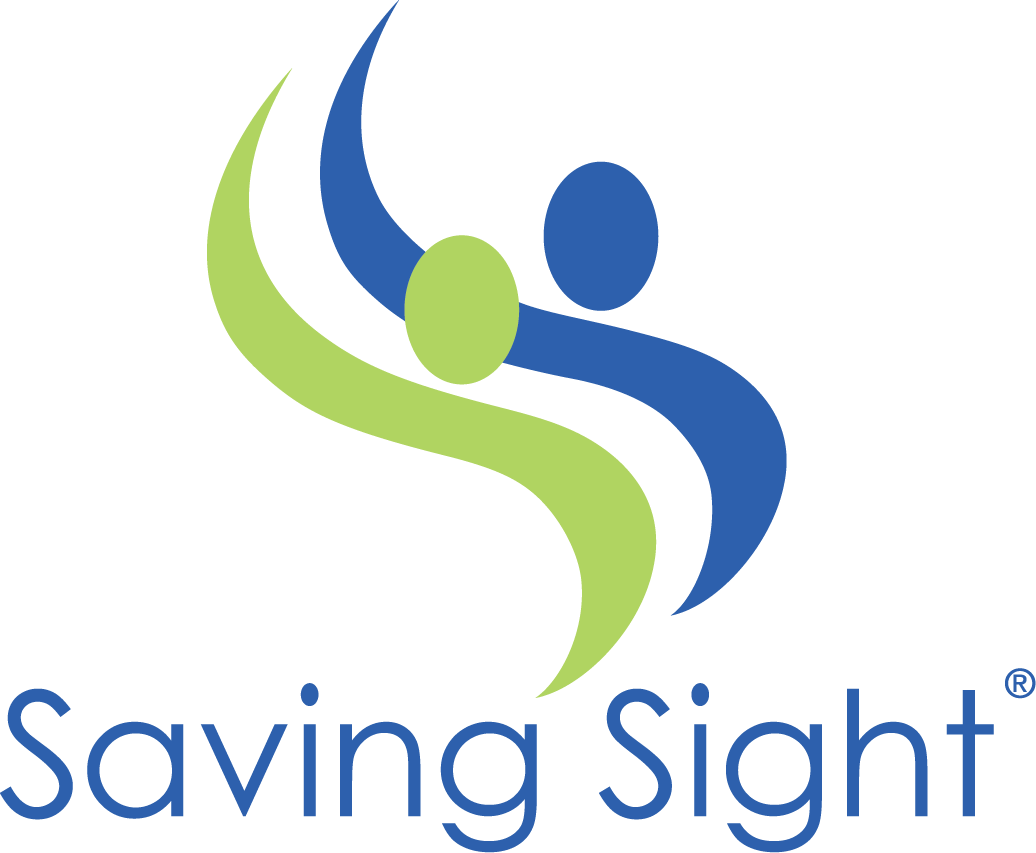Industry News
Quality Assurance Department Highlight
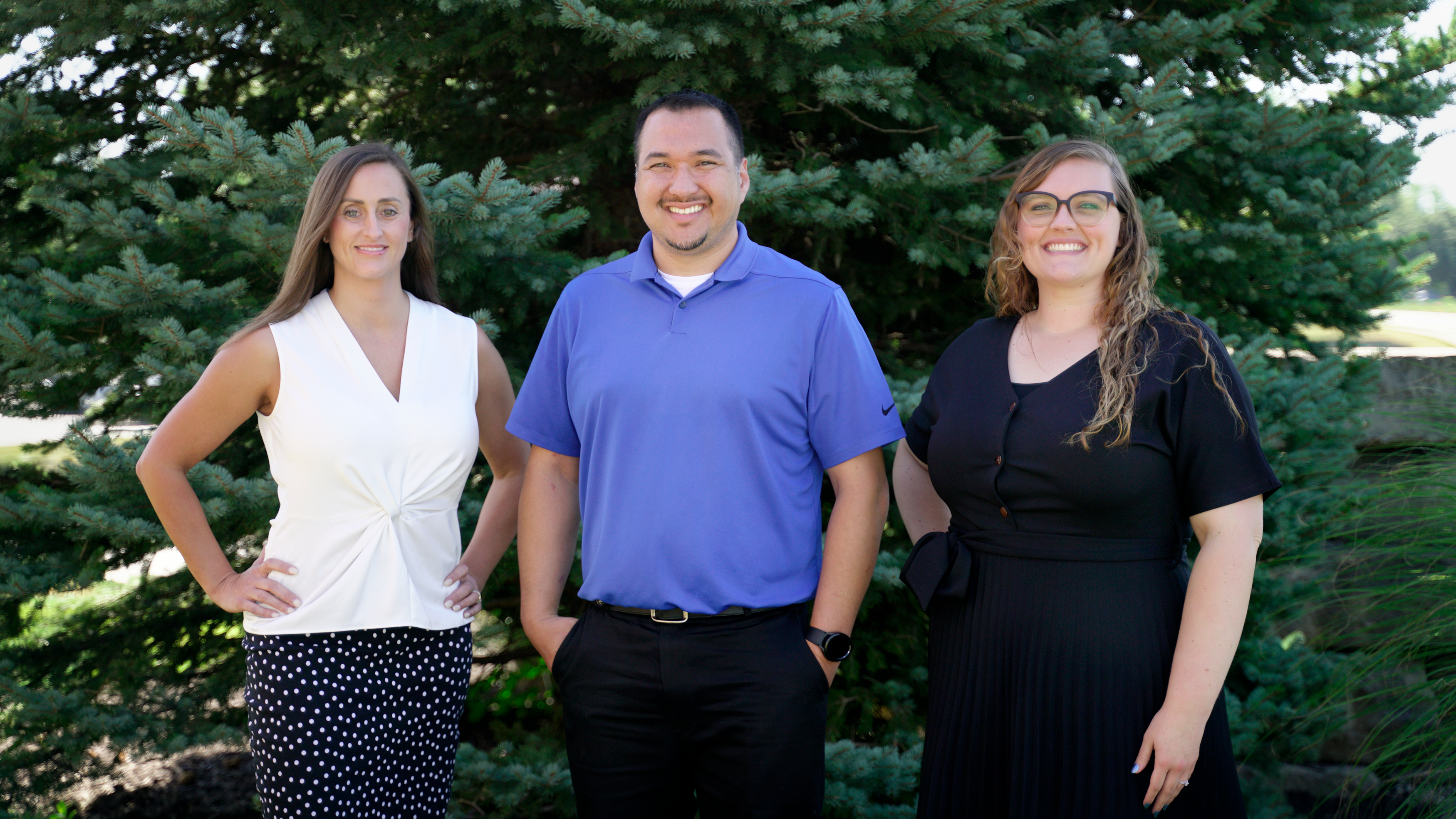
The Quality Assurance department is designed to prevent, detect, and correct deficiencies that may lead to circumstances that increase the risk of introduction, transmission, or spread of communicable diseases, and is an integral part of Saving Sight and Vital Tears operations. At Saving Sight, the Quality Assurance Department is made up of three team members: Patrick Johnson – Director of Quality Improvement and Regulatory Affairs, Kristine Kennedy – Quality Improvement Specialist and Jessica Cody – Quality Improvement Specialist. While each member has their own responsibilities and title, “in the end, we are a team and complete all task as a team,” says Kristine Kennedy.
Like any department, each day is different, but in the Quality Assurance Department you can find them in meetings, working on projects, auditing different processes, not only in our main office in Kansas City but in each of our satellite offices. “Quality Assurance is part of every aspect of Saving Sight and Vital Tears” says Kristine Kennedy. This could be helping a team understand how to complete regulatory documentation or verifying that documentation is completed correctly. It might be improving SOPs for departments to clearly understand requirements or improve a process. Quality Assurance is a vital part of helping the organizations operate to stay in compliance and improve the overall quality of the operation. They are ultimately responsible for quality improvement and assurance, making sure we are following the rules set forth by HIPAA, Non-Conformance Management, both internal and external audits, OSHA incident tracking and supply and supplier management. No day is the same, but they play and important role in making sure we are being good stewards of the gift of sight.
“The Quality Assurance department has been a very rewarding job for me. I truly love being able to help other departments grow in their learning and support them in improving their processes. This roll requires organization, problem solving, “out of the box thinking,” and teamwork, just to name a few. I am so incredibly blessed to work with such amazing people that are dedicated to our mission. I have the best teammates EVER, that are always willing to step up, have each other’s back, and support one another” says Kristine Kennedy. Saving Sight truly is lucky to have such a caring and devoted group of people, all helping us in our mission to change lives by Saving Sight.
Celebrate Safely This Fourth of July!
While fireworks are a beautiful and time-honored tradition associated with the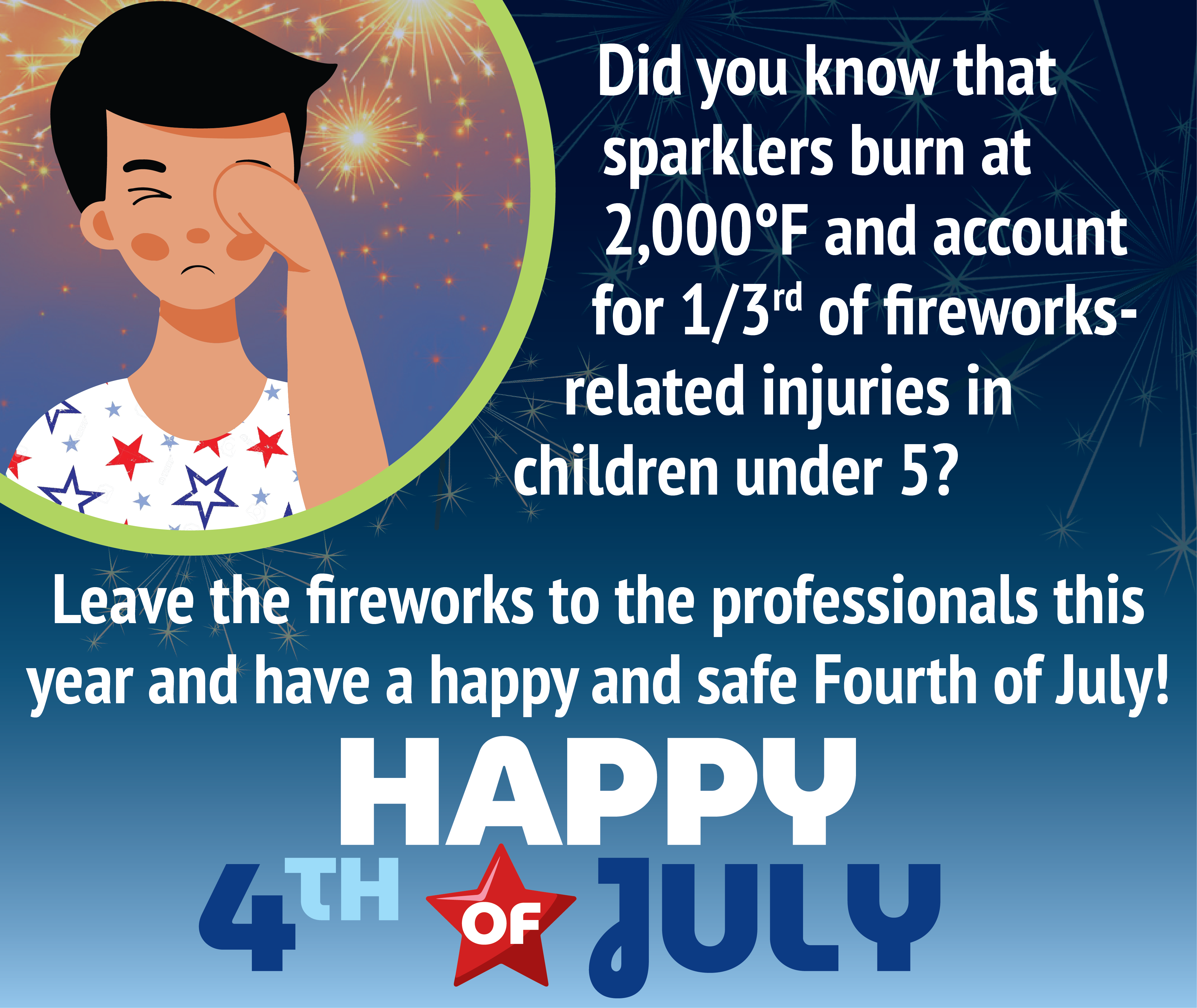 holiday, it’s important that you take precautions to keep yourself and your loved ones safe. Here are some quick facts about fireworks, and some tips to keep your vision safe this year while still enjoying the festive fun.
holiday, it’s important that you take precautions to keep yourself and your loved ones safe. Here are some quick facts about fireworks, and some tips to keep your vision safe this year while still enjoying the festive fun.
The U.S. Consumer Product Safety Commission reports that there are 9,000 fireworks-related injuries each year in the U.S. Thirty percent of those are eye injuries, and one-fourth of those eye injuries result in blindness. What’s more, children account for the majority of fireworks-injury victims, and for children under 5, sparklers — which burn at 2,000 degrees Fahrenheit and can cause third-degree burns — account for one-third of fireworks-related injuries.
For these reasons, the American Academy of Ophthalmology encourages you to follow these recommendations:
- Never let children play with fireworks of any type.
- View fireworks from a safe distance: at least 500 feet away, or up to a quarter of a mile for best viewing.
- Leave the lighting of fireworks to trained professionals.
- Follow directives given by event ushers and public safety personnel.
- Respect safety barriers set up to allow pyrotechnicians to do their jobs safely.
- If you find unexploded fireworks remains, do not touch them. Immediately contact your local fire or police department.
- If you get an eye injury from fireworks, seek medical help immediately.
If you do decide to shoot off fireworks yourself, be sure to follow all safety precautions, protect your eyes, and keep children a safe distance away. The staff at Saving Sight wishes you a safe and fun-filled Independence Day weekend!
Looking for More?
Want some additional Independence Day Safety tips? Check out our friends at the American Academy of Ophthalmology!
Communicating Saving Sight’s Impact
At Saving Sight, our Communications team is responsible for internal and external communications, sharing donor family and recipient stories, branding, marketing, and connecting with our Lions Club volunteers. Our job is to tell the story of our mission to connect and encourage stakeholders to join us in changing lives by saving sight.
Our team encourages recipients and donor families to share their stories with us and in turn, we share those stories through multiple 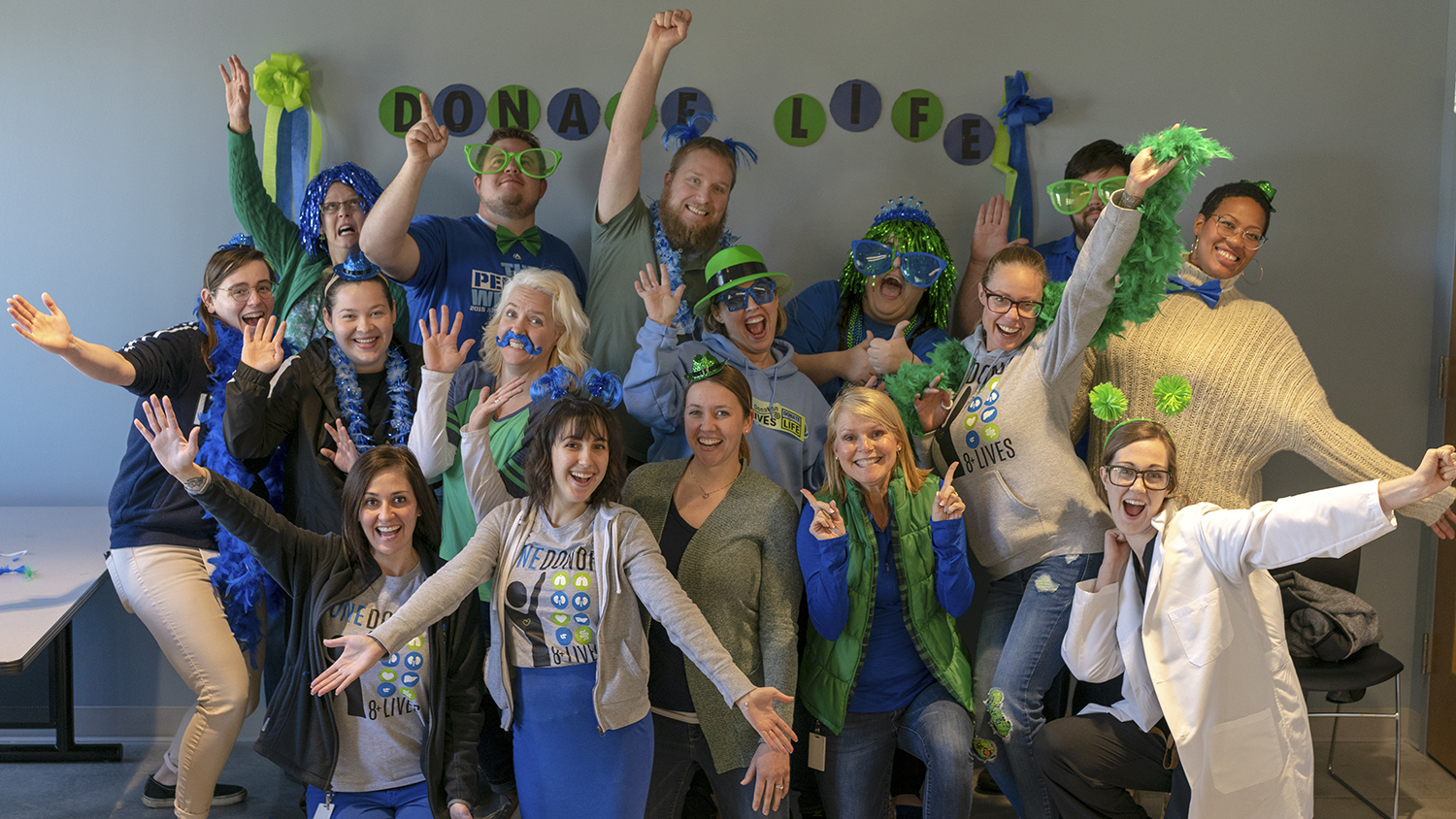 channels. When a story is shared with us, we share it on our social media platforms, on our website, and during our mission moments internally. These mission-centered stories really help put into perspective our mission which is to change lives by saving sight. The stories shared with us not only remind us here at Saving Sight why we do this work and why donation is so important, but it also helps spread the word about donation.
channels. When a story is shared with us, we share it on our social media platforms, on our website, and during our mission moments internally. These mission-centered stories really help put into perspective our mission which is to change lives by saving sight. The stories shared with us not only remind us here at Saving Sight why we do this work and why donation is so important, but it also helps spread the word about donation.
Another area that the Communications team is responsible for is overseeing correspondence between donor families and recipients. Many recipients and donor families are interested in communication opportunities, so we offer the opportunity to correspond anonymously between donor families and recipients. When Saving Sight receives a letter, we send it on to the appropriate party and allow them to correspond back and forth.
We also support donor designation by recruiting volunteers to help us at events that spread awareness for organ, eye, and tissue donation. By sending volunteer cards out in our weekly and monthly letters we hear back from people impacted by the work we do at Saving Sight. For example, we recently had a volunteer speaker at the Missouri State Capital for Donor Family Recognition Day and we are currently recruiting volunteers for future events.
With the help and support of Lions Clubs and our Lions board members, we can help communicate about the work we do with various stakeholders. We can connect donor families and recipients to help the healing process, share stories with our staff and on our social media and recruit volunteers to help with donor designation. Thank you for all the work you do in helping us change lives by saving sight.
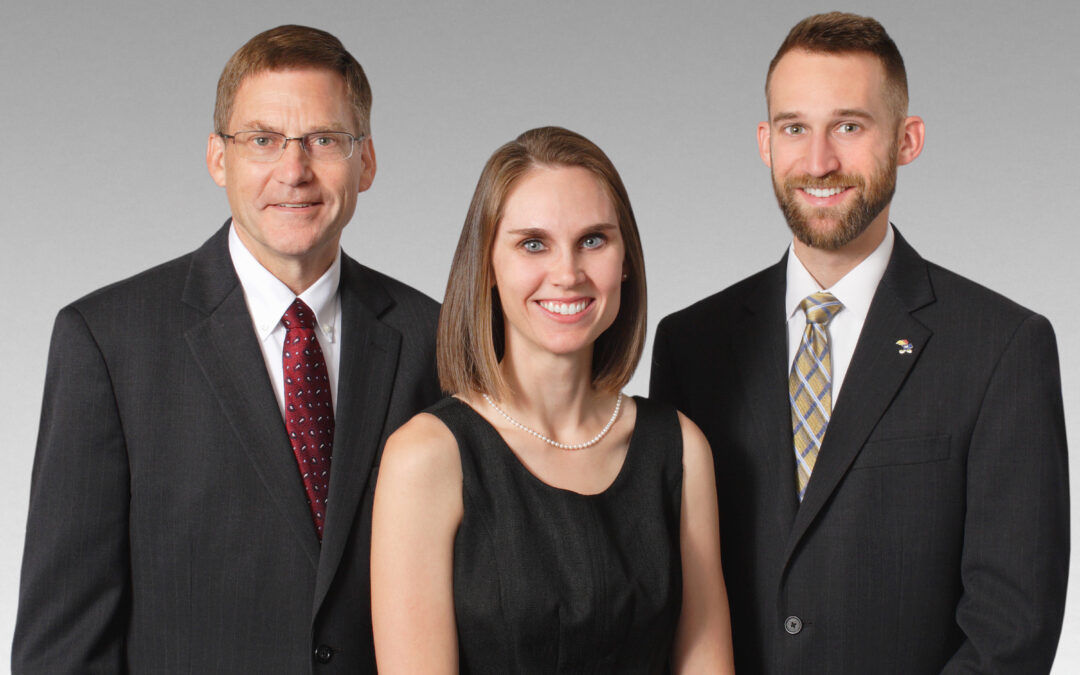
Champion of Sight – Downing & Lahey Funeral Home
Downing and Lahey Funeral Home, located in Wichita, Kansas, has been chosen as Saving Sight’s first Champion of Sight. The Champion of Sight Award recognizes our partners who exhibit extraordinary dedication in advocating and assisting in making eye donation possible. Together, with our Champions, we truly change lives by saving sight! Champions of Sight are nominated by and voted for by our team here at Saving Sight.
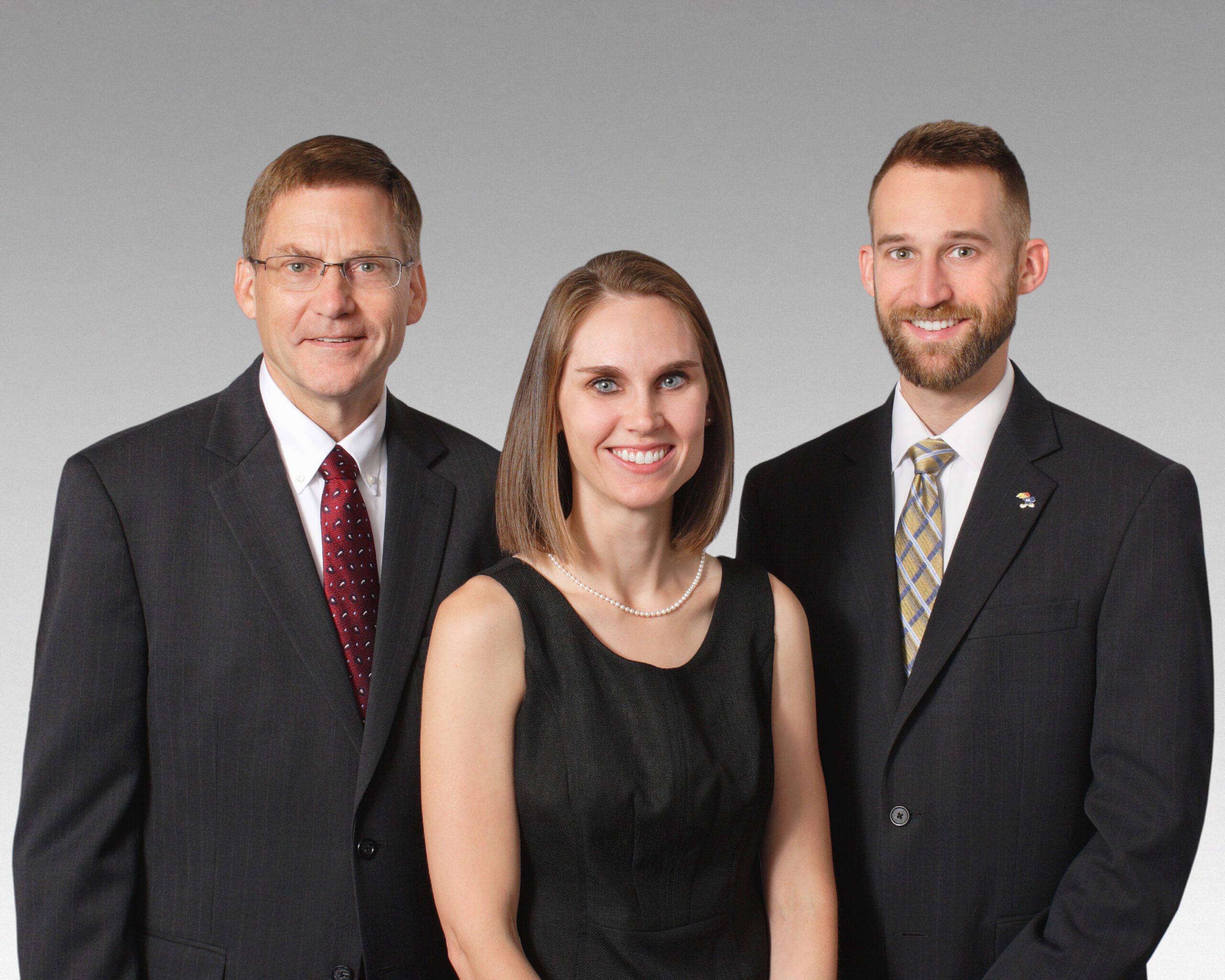
Our partners at Downing and Lahey Funeral Home work to help support the donation wishes of decedents and their families.
“We chose Downing and Lahey for their open communication. When I called to introduce myself, they let me know some areas of opportunity and how we could make them better. I followed up as promised by emailing their funeral home directors our commitment,” says Hospital Development Manager Kelly Falwell. We are lucky to have such great partners at Saving Sight that play a part in facilitating the eye donation process and advocating for donation, donor families and recipients in our service area. Downing and Lahey has been a great partner to Saving Sight by allowing our recovery technicians to perform recoveries in the funeral home from time to time.
Michael Morris, Funeral Director with Downing and Lahey says, “We understand the importance of donation and giving somebody the opportunity to see from somebody that’s passed away. That’s a great thing to be able to share with someone.” By working in tandem with funeral homes, we are able to honor the donor and their families’ wishes in being a donor.
Honoring the Legacy of Wichita Eye Donors
In June 2021, Saving Sight and the Kansas Eye Bank joined together in a partnership to serve the entire state of Kansas. Our new Wichita facility has rich history of serving its community by facilitating the gift of sight. We’re happy to share the following images from the donor quilts that were made over the years, celebrating the legacy that Wichita-area eye donors left in their selfless gifts.









Facilitating the Gift of Sight | Donor Services Center Spotlight
Saving Sight’s Donor Services Center (DSC) plays a vital role in facilitating the gift of eye donation for thousands of individuals each year. Our DSC serves as the communications hub of Saving Sight’s eye banking operations. The department, staffed 24 hours a day, seven days a week, keeps the donation process moving forward and helps fulfill the wishes of potential eye donors.
A DSC coordinator’s work begins when they receive a referral for a potential donor case from one of our organ procurement organization partners (OPO). The coordinator will then conduct a referral screening call with the nursing staff at the hospital that referred the death. If the potential donor meets Saving Sight’s referral criteria, the coordinator will contact the next-of-kin to discuss the opportunity for eye donation. Our DSC team will also conduct an in-depth medical and social screening interview with the donor’s next-of-kin to identify any potential rule-outs for donation.
donor case from one of our organ procurement organization partners (OPO). The coordinator will then conduct a referral screening call with the nursing staff at the hospital that referred the death. If the potential donor meets Saving Sight’s referral criteria, the coordinator will contact the next-of-kin to discuss the opportunity for eye donation. Our DSC team will also conduct an in-depth medical and social screening interview with the donor’s next-of-kin to identify any potential rule-outs for donation.
Once the DSC has determined that Saving Sight can move forward with recovering the donor’s gift of eye donation, they dispatch a recovery technician on site. They will also make courtesy calls back to the donor hospital and the funeral home to keep them up-to-date on the recovery technician’s arrival and departure.
At the same time, the DSC team will work to gain access to the patient’s medical chart. They will review records for any potential rule-outs for donation to ensure safety for the transplant recipient. Finally, specially trained DSC team members will conduct a final review of medical records, serology results, and any other important information to the case to determine final eligibility and release for transplant.
The DSC’s work happens quickly, and eye donation recovery must happen within 24 hours from the time of death. Therefore, the DSC team members must exhibit excellent multi-tasking skills while also compassionately communicating with various stakeholders, including grieving families. We’re proud to have a group of caring and highly skilled individuals who work in our Donor Services Center!
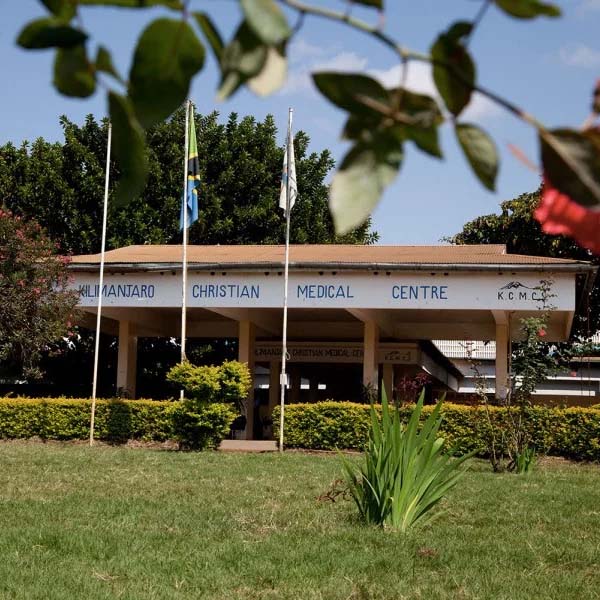
Changing Lives Through Sight Restoration in Tanzania
On July 2, 2021, Saving Sight distributed 6 corneal tissues to the Donor Network of Arizona to be used by one of their surgeons in Tanzania for a mission trip.
Dr. LeeSa Jackson joined Dr. Elisante Jackson Muna at the Kilimanjaro Christian Medical Center to perform a total of 17 gratis surgeries between the dates of July 5th-16th, to those in need.
This trip was not Dr. Jackson’s first to Tanzania. In 2018, Dr. Jackson traveled to Tanzania to perform 18 corneal transplants.
The medical team gathered stories from each recipient. Read the impact these sight-saving corneal transplants had for the corneal recipients below.

[Saving Sight recipients, Top L-R: Edson Mika, Bright Shipella, Meshack Nzowa; Bottom
L-R: Joshua Martin, Omary Hindu, Neema Mkwizu]
Edson Mika
Edson Mika is a 31-year-old medical doctor who works as a general practitioner in the Dodoma region. The most challenging problem for Edson is his poor vision from keratoconus. Overtime, his keratoconus became worse and worse, and his poor vision became a major problem in his career. He could not see to take care of his patients or write in his patients’ charts. Edson tried a variety of medicines to aid his vision, but there was little benefit. Edson greatly appreciates the cornea donation because, as he notes, “we all have things to do in our lives, so it is important to have the donation.” More simply, Edson “thanks the donor very much.” As a general doctor who has experienced a cornea transplant, Edson believes organ transplantation is good because it allows people to continue on with their lives in the best way. He says that we should ask the question, “Does it help me now?” The advice Edson would give someone in his position is to take full advantage of the ability to see well again. He indicates that his poor vision before the cornea transplant was the only thing holding him back and now he hopes to “progress well” in his career as a doctor.
Bright Shipella
Bright Shipella is a 12-year-old boy from Dodoma, the capital of Tanzania. Bright lives with his two siblings and loves to play soccer. However, due to his poor vision from keratoconus, Bright couldn’t see the ball to play soccer anymore. Bright says he has fought through the inflammation of his eyes and poor vision. He wishes to improve his soccer skills, but only wants to compete recreationally or on the local level. As a prime career goal, Bright plans on becoming a doctor. Bright sends the following message to others who may be considering a cornea transplant. “I feel good. My eye vision is performing well. I can now see the blackboard.” (likely referencing the blackboard near the hospital bed.)
Meshak Nzowa
Meshak Nzowa is a 20-year-old young man from Tanzania who lives with his parents and younger brother. He previously tried traditional medicine, contact lenses, and glasses, which helped his cornea deformity, keratoconus, only temporarily or not at all. As a student, Meshak finds it extremely difficult to read a book. When he attends local basketball game, Meshak is unable to see the score. At night, he finds it challenging to walk because he cannot see his way. Because of these difficulties, Meshak would tell the donor that is truly made a difference and that it is without a doubt helpful. His advice to people in his position it to recognize the importance of the problem earlier on so they can make the most of their remaining life. Now that he has had his cornea transplant surgery, Meshak hopes to become ore involved in the local basketball leagues as a player, not just a fan. His short-term goals are to continue his education to be accepted into high school and then into a university. Meshak’s prime long-term goals is to become a doctor, specifically an ophthalmologist, in order to help patients, like himself who have keratoconus. Meshak is confident that he will be able to study much better now with his improved vision, so he sees these goals within his grasp.
Joshua Martin
Joshua Martin is a 19-year-old student who attends Karagwe University. He lives at the university in the Karagwe District of the Kagera Region. Joshua has many brothers and a younger sister who live with his parents at his family home. In Joshua’s free time, he loves to draw letters, various types of calligraphy, and portraits of people. Due to Joshua’s poor vision in his left eye from keratoconus, he had difficulty at school taking down information from the blackboard and reading books, even with the help of friends. The keratoconus eventually affected Joshua’s vision so severely in his left eye that he only used one eye, his right eye, to do school related tasks. At this point, he considered dropping out of the university because of his poor vision and “doing anything that would possibly fit my society.” To the person who donated the cornea, Joshua says, “I just give a good thanks to him or her whomever he or she is because they just changed my whole life.” Now that Joshua’s vision has improved after the cornea transplant in his left eye, he plans to continue his education at Karagwe University.
Omary Idd Hindu
Omary Idd Hindu is a 25-year-old ticket salesman from Babati Mjini District in the Manyara Region. In his daily life, Omary reads over, cuts, and sells many train tickets with very small text. His poor vision has made his work as a train ticket salesman significantly more difficult, almost nearly impossible. Omary has corneal scarring due to hydrops associated with keratoconus. His poor vision began after he began scratching his eyes as a result of exposure to a strong perfume which irritated his eyes. In an effort to improve his vision, Omary tried multiple mediciations that, in the end, did not help. Omary has had to wait years for his cornea transplant surgery. To the person who donated the cornea, Omary says, “God bless them, and I am so thankful for that…And by the help of God and the doctors, I can be better now.”
Neema Omary Mkwizu
Neema Omary Mkwizu is a 12-year-old girl from the Wilaya ya Arusha Mjini District in the Arusha Region. Neema is an only-child, which is rare in the Tanzanian culture. When Neema is not attending school, she loves to read and write about historical information. Neema’s case of keratoconus occurred idiopathically. She has no associated risk factors, or systemic or ocular conditions associated with her keratoconus. Her vision was not helped by other treatments, including spectacles. To the person who donated the cornea, Neema simply states, “thank you.” To others who may be in her position, she advises them to read books and, as a result, gain knowledge. Neema’s favorite historical location is the Amazon Rainforest, which she hopes to travel to and learn more about in her future. Neema plans to become a history teacher or an eye doctor, specifically a cornea specialist, so that she can treat others with her same problem.
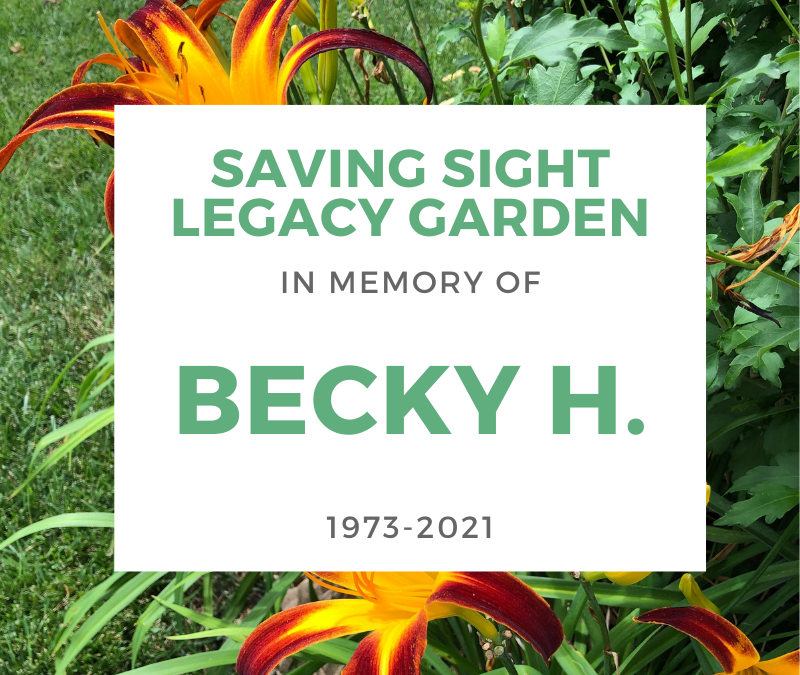
Becky’s Legacy

In Memory of Becky H., 1973-2021
“Becky was a strong advocate for those in need, especially children. She loved genealogy, German food, and her family and friends,” says Eric.
#LegacyGarden #DonorHero
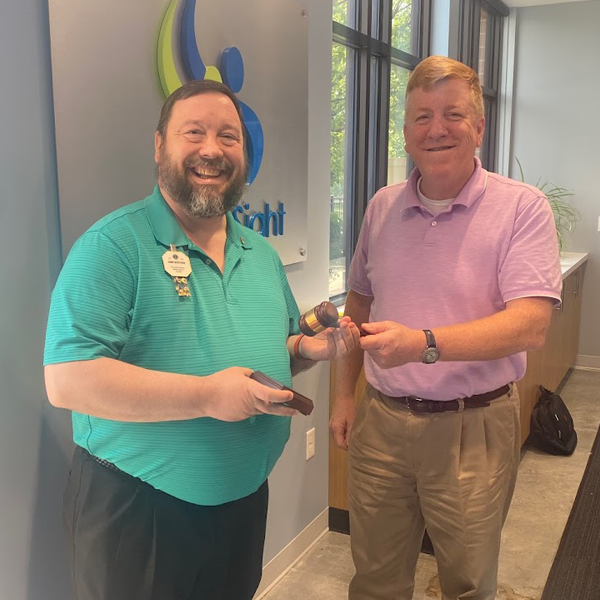
Saving Sight Introduces the 2021-2022 Board of Directors

[pictured L-R: Pat Martchink passing the gavel to Larry Boettcher; Cassidy Obermark being honored for her board service; the board meeting at the Kansas City C office at the June meeting.]
Kansas City, Mo. (July 1, 2021) – Saving Sight is pleased to welcome four new people to its Board of Directors for the 2021-2022 fiscal year (July 1 – June 30). Welcome Council Chair Lion Bob Noellsch, Vice-Council Chair Lion Devin Struttmann, Lion Mike Sliger, and Wichita community board member Marc Vincent. PDG Lion Scott Sattler remains on the board and switched seats to represent Lions District M-1, Lion Larry Boettcher was re-elected to a second term, as well as community members Jeff Schaeperkoetter and Amy Leslie.
Board members are key to the organization’s success. They actively participate in long-range planning and monitor the organization’s financial health and overall performance. As highly visible members of their communities, the board members also enhance Saving Sight’s public standing by sharing the mission, accomplishments, and goals with Lions clubs, the general public, and other partner organizations. As Lion board members, these individuals also keep their districts informed about Saving Sight.
“We are able to change more lives by saving sight due to our board members engagement, leadership, support and oversight,” said Tony Bavuso, chief executive officer.
In addition to welcoming new members to the board, Saving Sight also expressed gratitude to three individuals who retired from the board of directors on June 1, 2021. We were honored to have PCC George Winkeler, Jr., PDG Roger Tiemann, and Lion Dr. Cassidy Obermark serve on our board and thank them for their valuable service.
At the June Board of Directors meeting, the board elected its 2021-2022 leadership team.
These board members were elected to leadership roles for the new fiscal year:
President: PCC Larry Boettcher, MD-26 M4
Vice President: Lion Pat Martchink, MD-26 M2
Treasurer: Lion Mike Oldelehr, MD-26 M7
Secretary: PDG Scott Sattler, MD-26 M1
At the June board meeting, past president Lion Pat Martchink ceremoniously passed the gavel to newly elected president PCC Larry Boettcher. Pat will serve as vice president for the 2021-2022 fiscal year to ensure a smooth leadership transition.
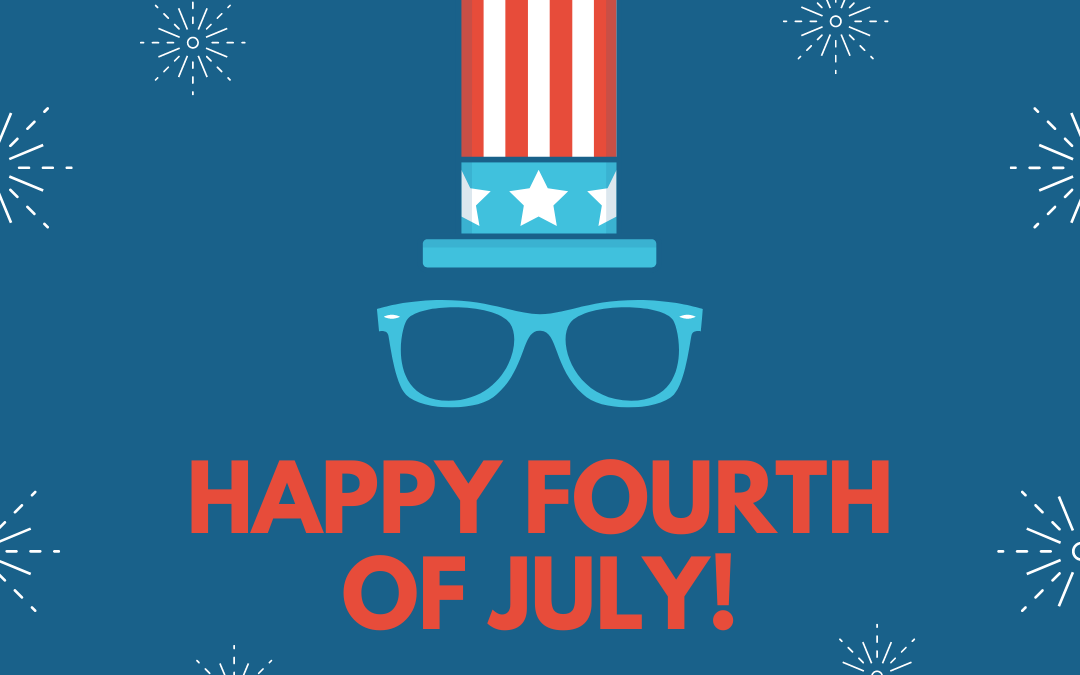
Practice Eye Safety This Independence Day
 This year, we hope you enjoy a fun and safe Fourth of July with friends and family. While fireworks are a beautiful and time-honored tradition associated with the holiday, it’s important that you take precautions to keep yourself and your loved ones safe.
This year, we hope you enjoy a fun and safe Fourth of July with friends and family. While fireworks are a beautiful and time-honored tradition associated with the holiday, it’s important that you take precautions to keep yourself and your loved ones safe.
The U.S. Consumer Product Safety Commission reports that there are 9,000 fireworks-related injuries each year in the U.S. Thirty percent of those are eye injuries, and one-fourth of those eye injuries result in blindness. What’s more, children account for the majority of fireworks-injury victims, and for children under 5, sparklers — which burn at 2,000 degrees Fahrenheit and can cause third-degree burns — account for one-third of fireworks-related injuries.
For these reasons, the American Academy of Ophthalmology encourages you to follow these recommendations:
- Never let children play with fireworks of any type.
- View fireworks from a safe distance: at least 500 feet away, or up to a quarter of a mile for best viewing.
- Leave the lighting of fireworks to trained professionals.
- Follow directives given by event ushers and public safety personnel.
- Respect safety barriers set up to allow pyrotechnicians to do their jobs safely.
- If you find unexploded fireworks remains, do not touch them. Immediately contact your local fire or police department.
- If you get an eye injury from fireworks, seek medical help immediately.
If you do decide to shoot off fireworks yourself, be sure to follow all safety precautions, protect your eyes, and keep children a safe distance away. The staff at Saving Sight wishes you a safe and fun-filled Independence Day weekend
Get the Latest in Your Inbox
Sign up below to receive Saving Sight’s quarterly round-up of industry news straight to your inbox. We will never share your information with third parties and you may unsubscribe at any time.
